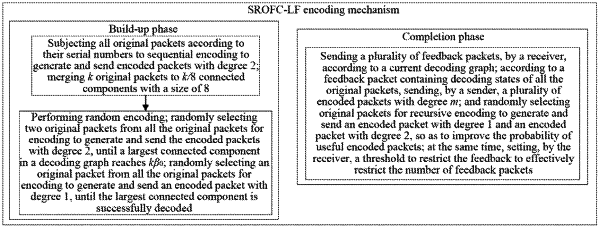| CPC H04L 1/005 (2013.01) [H04B 13/02 (2013.01); H04L 1/0061 (2013.01)] | 6 Claims |

|
1. A data encoding and decoding method for underwater acoustic networks (UANs) based on an improved online fountain code, wherein the improved online fountain code is a sequential recursive online fountain code with limited feedback (SROFC-LF); data encoding and decoding are performed via a SROFC-LF encoding mechanism; and the method comprises:
in a build-up phase, based on the SROFC-LF encoding mechanism, subjecting all original packets to sequential encoding according to serial numbers of the original packets to generate and send encoded packets with degree 2; merging k original packets to form k/8 connected components with a size of 8; performing random encoding by randomly selecting two original packets from all the original packets for encoding to generate and send an encoded packet with degree 2, until a size of a largest connected component in a decoding graph reaches kβ0; randomly selecting an original packet from all the original packets for encoding to generate and send an encoded packet with degree 1, until the largest connected component is successfully decoded; and
in a completion phase, sending, by a receiver, a plurality of feedback packets according to a current state of the decoding graph; according to a feedback packet containing decoding states of all the original packets, sending, by a sender, coding packets with degree m, and then randomly selecting original packets for recursive encoding to generate and send an encoded packet with degree 1 and an encoded packet with degree 2, so as to make each coding packet useful for decoding; and at the same time, setting, by the receiver, a threshold to restrict a number of feedback packets.
|